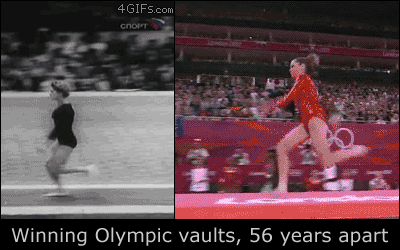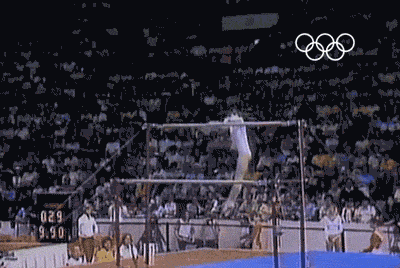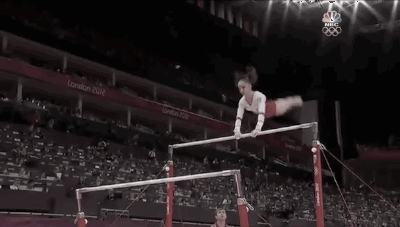
WAG Gymnastics
101
EQUIPMENT AND ITS EVOLUTION

VAULT:
The vaulting table used to be exactly like a pommel horse, except there were no handles. The gymnast would look at the vault horizontaly. The design of this vault was okay in the beginning when everything was much simpler ( front handsprings) and then the vaults started to get more complex and the fear was very high. Gymnast were afraid of missing their hands.
The new vaulting table was redesigned to be used in the 2004 Olympics. The new vault eliminated fear and produced harder and more aggressive vaults. The newer vault is designed to be longer and wider then the old one. The vault is angled slightly. The reason for this goes along with Newton's Third law. Gymnasts come into contact with the table in a downward angle and when the intial force reacts with the table the gymnast recieves a "bump"( upwards force).




UNEVEN BARS:
The uneven bars for women used to be a set of men's parallel bars raised at different levels. They were very close together and could not go wider or higher.
The new uneven bars for women have been modified to provide stability, flexibility, and adjustment for all gymnasts. The new bar rails have been made with fiberglass with a wood coating. The fiberglass allows for the bars to bend and move with the gymnast and the wood coating adds durability and higher friction with the chalk and water that gymnast use. Not only this, but the bars have been made so that they are adjustable. The high bar and low bar can raised for taller gymnasts and the bars can also move farther apart. Now the standard setting of the new bars is 1.80 m apart diagonally. Also the cables around the bars allow for tension adjustments and so the force from the gymnast can evenly disperse the energy. The cables also act for stability in the bars set. The cables screw into the ground are placed apart from each other so that it forms a nice solid base.


BALANCE BEAM:
There are no changes to the iconic balance beam. According to International Federation of Gymnastics (FIG) the balance beam is covered by an elastic overlay with a cushioning that is between 15mm and 30mm thick. The ends of the five-meter long beam must have rounded edges and the beam itself is required to stand 1.2m off the ground. The balance beam is 4 inches wide.






FLOOR EXERCISE:
Before the floors for gymnastics was just carpet. There were springs to help the gymnasts. It was very hard on the gymnast's body and took away the force and power of the gymnasts.
Now the new floors are made with carpet on the top layer, foam in the middle, then plywood, and lastly little springs along the bottom. The carpet design varies depending upon the equipment company but for the most part it has stayed the same. Then attached to the carpet is the foam. The foam is stiff so that it does not absorb all the applied force but acts as cushioning for the gymnast. The foam is designed to quickly respond to the gymnast's fast pace in tumbling and multiple impulses. The plywood is made so that the floor has some stiffness and so that there is something for the springs to attach to.The springs are placed strategically around the floor so that there is a larger centre of percussion. This means that the gymnast will feel less pain in their joints (vibration) and get more height and rebound faster (force transfer).

Source: Gymnastics Canada, Speith, GIFS & SA Sports